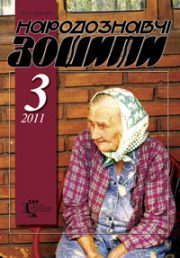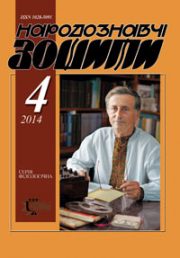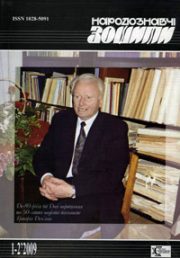The Ethnology Notebooks. 2020. № 1 (151), 109—116
UDK398:[7.011.26.042:598.2](=172)
DOI https://doi.org/10.15407/nz2020.01.109
BIRD SYMBOLISM IN LITHUANIAN (BALTIC) FOLKLORE AND FOLK ART
GAIDAMAVICIUTE Ona
ORCID ID: https://orcid.org/0000-0001-9181-7208
master of Lithuanian philology, master of art history
senior museologist worker,
Lithuanian national museum,
Department of the Ethnic culture,
Arsenalo g.~1, Vilnius 01143
Abstract. Introduction. I suppose that the birds are the mediators of heaven and earth. The prophetic chanting of birds, the ability to fly in the sky, the ability to land on plants, the particular behavior of the human senses were associated with the rhythm of nature and its eternal change, the dynamism of space, the continuity of life. In folk art, birds are depicted on both sides of trees and flowers, crosses or roof poles, and if one at the top. Birds are depicted with wheels, concentric circles. They land on either side of the circle or within the circle itself. Folk art continues the millennial tradition of giving importance to birds. Still, one of the most important birds in Lithuanian folklore, especially the singing cuckoo, the destiny maker, the prophet of death, the «ancestor» of the goddess Laima, the fate bird.
Problem statement. Obviously, the image of the bird, which carries various symbolic meanings, is very important in Lithuanian, or rather Baltic, folklore and iconography. Birds in folklore, religion, perform many functions related to all stages of human life (birth, marriage, death), transformation, and accompany throughout human life. Birds are also mediators between heaven and earth, between the living and the dead. The purpose of this work is to discuss and summarize the symbolism of the bird phenomenon in Baltic folklore and iconography. There will also be a comparative study of Slavic folklore and iconography.
The purpose of this work is to discuss and summarize the symbolism of the bird phenomenon in Baltic folklore and iconography. There will also be a comparative study of Slavic folklore and iconography.
Methods. Complex interdisciplinary research is used — ethnographic, iconographic methods, as well as folklore (both singing and narrative), folk art and ethnolinguistic material.
Keywords: the birds, iconography, folk art, Baltic folklore, the Cuckoo, goddess Laima, incarnation, birds-psychopomps, sacredness, the World Tree, structural-semantic analysis.
Received 20.01.2020
REFERENCES
Jasiūnaitė, B. (2006) Saints and wicked in phraseology and folk culture. Vilnius : Vilnius University Press [in Lithuanian].
Dundulienė, P. (2006) Birds in Old Lithuanian Beliefs and Art. Vilnius: Science and Encyclopedia Publishing Center [in Lithuanian].
Olindaitė, V. (2005) Texts and Contexts: Language Movement. Kaunas : VU Press [in English].
Olindaitė, V. (1986) Birds in Lithuanian Folk Songs. Young Philologists’ Works. [in Lithuanian].
Љeљkauskaitė, D. (2011) Erotica in folklore. Sargelas : Kruenta [in Lithuanian].
Beresneviиius, G. (1990) Dausos. The Concept of Afterlife in the Old Lithuanian Worldview. Vilnius : Gimtinė /Taura [in Lithuanian].
Krėvė-Mickeviиius, V. (1930) Notes. X Volumes. Kaunas, Klaipėda [in Lithuanian].
Greimas, A. J. (2005) Studies of Lithuanian mythology. Compiled by Kкstutis Nastopka. Vilnius : Baltos lankos, 2005.
Kudirkienė, L. (2004) Folklore Image of the Cuckoo, Folklore Works, Vol. 21 (28). [in Lithuanian].
Trinkūnaitė, Ћ. (2002) Cuckoo image in singing folklore. Folklore Studies, № 23, 2002, p. 108—116 [in Lithuanian].
Gimbutienė, M. (1994). Ancient symbolism in Lithuanian folk art. Vilnius : Mintis [in Lithuanian].
Rimantas, B. (2006) Lithuanian and Prussian gods, goddesses and spirits: from rite to superstition. Klaipėda: Klaipėda University Press [in Lithuanian].
Zabulytė, J. (2006) Birds of Lithuanian Wooden Crosses: Interpretations of Meaning. Part I. Folk culture [in Lithuanian].
Dundulienė, P. (2006) Birds in Old Lithuanian Beliefs and Art. Vilnius : Science and Encyclopedia Publishing Center [in Lithuanian].
Gadon, E. (1989) The once and future Goddess. A sweeping visual chronicle of the Sacred female and her reemergence in the cultural mythology of our time. San Francisco : Harper, 1989 [in English].
Kaљinskaitė, M. (2014) Zoomorphic motifs in Lithuanian art. https://vb.vda.lt/object/elaba:2145474/2145474.pdf.
Keturka, A. (1987) Color in Lithuanian folk furniture decoration. Vilnius : Science. [in Lithuanian].
Usaиiovaitė, E. (1998) Lithuanian folk ornaments: peculiarities of peasant furniture decoration and symbolism. Vilnius : VDA Publishing House [in Lithuanian].
Dapљauskaitė, Ћ. (2008) Color and dйcor in the interior of Lithuanian dwellings in the XV—XIX cc. Master’s thesis. Kaunas : Kaunas Vytautas Magnus University [in Lithuanian].
Tumėnas, V. (2008) The Visual and the Mythical–Poetic Interpretations of Sky Luminaries In Lithuanian Traditional Textiles. Archeologia Baltica, vol. 10 [in English].
Tumėnas, V. (2002) Ornament of traditional Lithuanian belts. Typology and semantics. Ethnology of Lithuania. T. 9. Vilnius [in Lithuanian].






